The streets and riverbanks of Riba Roja resounded with the laments of disgruntled guides and disheartened anglers. It was our fourth day of six fishing the Ebro and hardly any catfish were being caught by anyone. We had a sense that the catfish were starting to wake up a bit, but I shall start with how our week began…
The first morning we were understandably high on a heady cocktail of anticipation, intrigue and enthusiasm. We wanted a good start so the pressure would be off, but none of us had seen the Ebro before, let alone fished it, yet its legend gave us high expectations. We boarded Carl’s California skiff, headed out to an island at the far side of the river and anchored up to cast our rigs for the first time. These were straightforward sliding floats through to heavy braided traces holding single size 3/0 heavy-gauge trebles. The stop-knots were set at around 80% depth and we lip-hooked bleak and trotted them downstream. We moved every 45 minutes or so and the third spot we settled in was full of features and looked perfect.
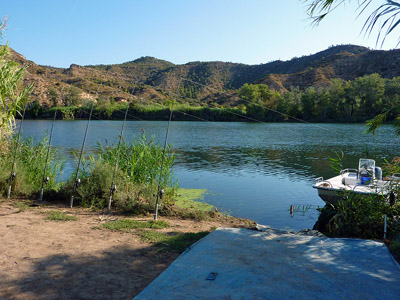 As we watched our floats steadily trotting, Shane’s float jerked downward, then back up again. It was very similar to a pike bite; the bulbous polystyrene bob float dipping dramatically a few times. Shane was poised ready to strike as soon as the bite developed, but this time the float resumed its tranquil journey and the biting fish never returned. A few minutes later the farthest downstream float bobbed as it approached an overhanging branch. I was closest, so I picked up the rod and wound down, but didn‘t quite take up enough slack before striking and thus, I failed to turn the bite into a catfish.
As we watched our floats steadily trotting, Shane’s float jerked downward, then back up again. It was very similar to a pike bite; the bulbous polystyrene bob float dipping dramatically a few times. Shane was poised ready to strike as soon as the bite developed, but this time the float resumed its tranquil journey and the biting fish never returned. A few minutes later the farthest downstream float bobbed as it approached an overhanging branch. I was closest, so I picked up the rod and wound down, but didn‘t quite take up enough slack before striking and thus, I failed to turn the bite into a catfish.
Next day we switched to a more active approach, trolling lures between the towns of Flix and Riba Roja. The conditions were perfect, with a steady flow and a downstream breeze which we could troll against to give us the perfect speed. We fished different styles of lures including large soft rubbers and crankbaits and steadily chugged along, holding the rods. Although we fished hard for a few hours, covering about eight miles of water, we didn’t have a take between us. On our last troll upstream we passed another boat drifting baits, clonking as they went. They too had caught nothing, so we ventured upstream and fished jigs on the drift over some deep holes. There was a brief zander feeding spell as detailed in part one, but we still couldn‘t find the catfish.
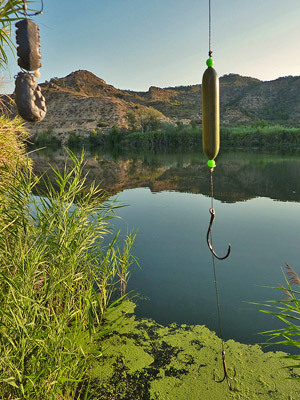 Our success with roach fishing the following day left us with some truly unbeatable baits which no other anglers or guides had. A group of bank anglers based at Riba Roja were starting to get a bit of attention from catfish but had to leave that evening and as our mobile approach had, disappointingly, not been working for the catfish it was clear we needed to try something new; so we decided to try in the swim these anglers were vacating.
Our success with roach fishing the following day left us with some truly unbeatable baits which no other anglers or guides had. A group of bank anglers based at Riba Roja were starting to get a bit of attention from catfish but had to leave that evening and as our mobile approach had, disappointingly, not been working for the catfish it was clear we needed to try something new; so we decided to try in the swim these anglers were vacating.
We used heavy cat rods equipped with big baitrunners and 150lb braid, with 20oz of lead to pin down our rigs which were popped-up with polyballs. We weren’t pulling any punches with hooks either, a size 7/0 single and 3/0 treble would cope with anything we might connect with. The Ebro rig mantra is ‘simple and strong’!
Setting the baits was a fine art but Carl’s boat skills made it half the job and it took a bit of practice and a lot of concentration to work in harmony with the guide to get the rigs out. The procedure was that Carl would bait the hooks then motor across the river with one eye on the echo sounder for the perfect spot then, once he gave the signal that the bait was on the deck, it was a case of reeling in as fast as possible to take up the slack before the current did. You knew you’d finished when you tightened to the 20oz lead!
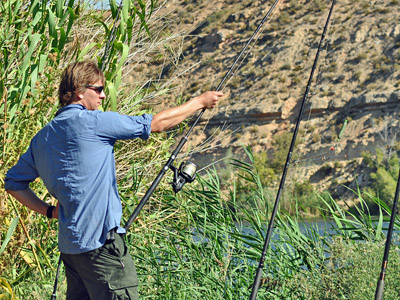 Once all five traps were set we had a very quiet morning, except for having to regularly re-set our rigs when weed took them out. We lazed in the shade of bamboo plants until mid-afternoon, when Carl spotted some major twitching on the middle rod tip. Having drawn the longest straw (I’d drawn the shortest), Shane stepped up for the first take, wound down and struck hard at the fish, as line started to peel from the Baitrunner.
Once all five traps were set we had a very quiet morning, except for having to regularly re-set our rigs when weed took them out. We lazed in the shade of bamboo plants until mid-afternoon, when Carl spotted some major twitching on the middle rod tip. Having drawn the longest straw (I’d drawn the shortest), Shane stepped up for the first take, wound down and struck hard at the fish, as line started to peel from the Baitrunner.
Although Shane was made to work to bring the fish in there was only ever going to be one victor. Our first bank-caught catfish was landed and the scales read 34lb on the nose. Buoyed by this first action, we all fished on until around 6 o’ clock, when Shane and Dave headed home. I was determined to get my first cat under my belt, so I asked Carl if I could carry on for an hour or so; which I did – begging the rods to go – but I still ended the day fishless.
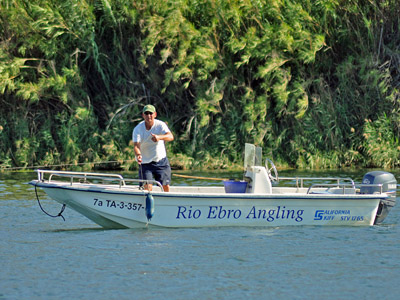 Next morning we had every bait in the water by 8.15am but it wasn’t until around midday that the first cat showed some interest. Due to my commitment the previous evening, Dave very kindly offered that I should take the next run. Line was being taken so I picked up the rod and struck as hard as I ever have; Carl had told us to “strike as if we were trying to break the rods” to ensure a good hook-set in the catfish’s bony mouth.
Next morning we had every bait in the water by 8.15am but it wasn’t until around midday that the first cat showed some interest. Due to my commitment the previous evening, Dave very kindly offered that I should take the next run. Line was being taken so I picked up the rod and struck as hard as I ever have; Carl had told us to “strike as if we were trying to break the rods” to ensure a good hook-set in the catfish’s bony mouth.
The fish instantly fought back but after a minute or so it felt like I was just reeling in the lead, which even on its own took some retrieving. I gave the rod a couple of sharp tugs and the fish woke up, got its head down and I just held on as the fish took line on a couple of powerful runs. Up until this point I had thought it was a small fish but when it turned I realised I was attached to a different calibre of beast to what we‘d had so far.
I got the first glimpse of a long, creamy flank in the marginal depths below. It looked huge and as that thought sank in, I realised it was also just a few feet from a submerged tree stump just out from the peg. Following Carl’s instructions, I brought the line over his right shoulder, he grabbed the leader and got a grip on the catfish’s lower jaw with his free hand. The tarpaulin “catfish runway” which we had set up on the floor in front of us was duly soaked in water and the fish was slid up it into the waiting weigh sling where it was unhooked.
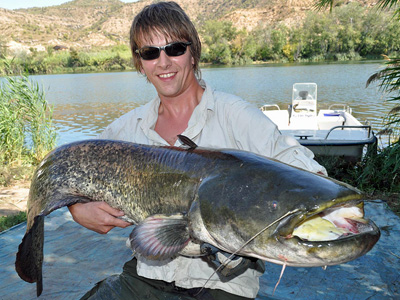 I was shaking by now and as Carl and I hoisted the weigh bar up, we had to rest it on our shoulders to get an accurate reading from the Reuben Heatons. They settled on 66lb; it was the largest fish I’d heard of being landed so far that week, so I eagerly took to the task of “slug juggling” to pose for some photos.
I was shaking by now and as Carl and I hoisted the weigh bar up, we had to rest it on our shoulders to get an accurate reading from the Reuben Heatons. They settled on 66lb; it was the largest fish I’d heard of being landed so far that week, so I eagerly took to the task of “slug juggling” to pose for some photos.
The next three hours flew by, before the next bite came, which Dave hooked into. I had started filming his progress in the battle when the reel on the farthest-upstream rod started screaming. Shane picked up this rod, hit into a very heavy fish and so began an epic battle. This bait had been placed furthest from our bank – at over 100 yards range – and initially any line Shane could gain on the fish, it took straight back from him.
Eventually he seemed to gain the upper hand and though the fish still had plenty in the tank, each run became less powerful. In the melee it managed to cross over another line which it proceeded to drag around. Suddenly a third reel started spewing line; my first thought was that this was another crossed line, then it dawned that we had a tripleheader!
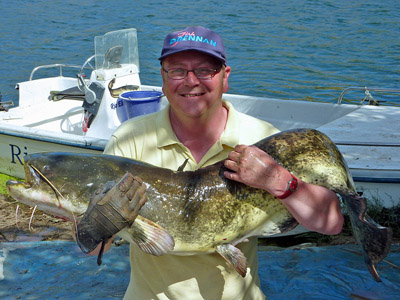 I hurriedly passed the camera to Dave, picked up the rod and hit home. I had a feeling straight away that this fish was small, so I concentrated on keeping us both out of Shane’s way and jumped onto the boat to play the fish from there. Meanwhile, Shane’s catfish had piled through a weed bed, bringing a huge ball of the stuff in with it, which had to be removed from the line. Unbeknown to us all, something abrasive inside the weed had damaged the braid and as Shane piled on the pressure – as if the last few minutes hadn’t been dramatic enough – the line snapped and disappeared out through the rod rings!
I hurriedly passed the camera to Dave, picked up the rod and hit home. I had a feeling straight away that this fish was small, so I concentrated on keeping us both out of Shane’s way and jumped onto the boat to play the fish from there. Meanwhile, Shane’s catfish had piled through a weed bed, bringing a huge ball of the stuff in with it, which had to be removed from the line. Unbeknown to us all, something abrasive inside the weed had damaged the braid and as Shane piled on the pressure – as if the last few minutes hadn’t been dramatic enough – the line snapped and disappeared out through the rod rings!
In this moment the contrast between hunter and hunted could not have been more profound. Shane was understandably frantic, whilst from my vantage point I could see the fish wallowing on the bottom, right beneath the boat. Thankfully, Carl’s instinct was to grab the other line, which was so tangled to Shane’s that he could pull it in far enough to grab the one with the catfish attached. Had the fish decided to run at this point, Carl would have had little choice but to let go of the line, so it was real heart-in-mouth stuff. I saw the fish turn to swim and I thought it was all over.
Flash to me; I had already brought my fish to the boat and clicked the anti-reverse off for a bit of fun whilst Shane’s fish was landed. His much bigger fish and current predicament had to take Carl‘s full concentration, so I grabbed a glove from in the boat and pulled it onto my left hand. I eased the fish towards me, grabbed the leader, then grabbed the fish’s lower jaw. Fish landed.
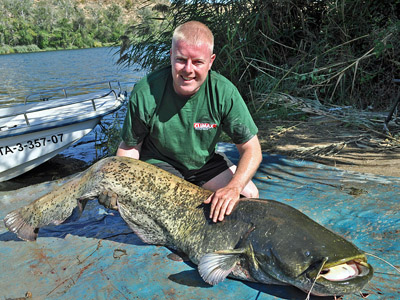 As I turned to exit the boat, Carl was hauling Shane’s fish up the bank. It dwarfed the 25lb fish I had in my hands and had an enormous head. All fight Shane had yelled, whooped and smiled, then he went through two minutes of despair, bewilderment and disappointment before finally relief and elation when the fish was on the bank. Rightly so too, because at 82lb 8oz it eclipsed everything else we’d caught.
As I turned to exit the boat, Carl was hauling Shane’s fish up the bank. It dwarfed the 25lb fish I had in my hands and had an enormous head. All fight Shane had yelled, whooped and smiled, then he went through two minutes of despair, bewilderment and disappointment before finally relief and elation when the fish was on the bank. Rightly so too, because at 82lb 8oz it eclipsed everything else we’d caught.
The feeding frenzy ended as quickly as it had started and we had no further action, but the ten minutes or so which passed from the first run to landing the third fish were some of the most exhilarating I‘ve ever experienced in fishing.
The final day came around so quickly and, after having a try for carp and zander in the morning, we came back to the bank, positioned the catfish rods and had breakfast at the peg to maximise our fishing time. At 11:35 Dave landed the first the fish, which turned out to be our smallest of the trip at only around 5lb. Two hours later there was a take on rod two and Shane stepped up to strike. This fish was much better and went 35lb. My turn came after half an hour, when a gentle bite came to rod four. I struck hard but from the outset it was clearly a small fish and so it proved when a six pounder came to the bank. Then at 14:45, rod one – which produced the biggest fish the day before – really screamed off! Dave picked the rod up, struck and clung on! He had a tremendous battle and we got some great underwater footage as the fish neared the shore. The scales nestled at bang-on 50lb, making it Dave’s biggest fish ever.
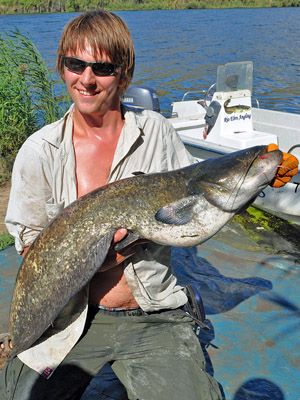 We’d had to work so hard to catch our catfish throughout the week and I think this made us appreciate each one so much more, whilst fishing for the other species kept us sane when the catfish weren’t having it.
We’d had to work so hard to catch our catfish throughout the week and I think this made us appreciate each one so much more, whilst fishing for the other species kept us sane when the catfish weren’t having it.
I have no doubt that without the knowledge and dedication of our guide Carl, we would have had far less action. Throughout the week he was cool as a cucumber and remained unfalteringly confident, always seeming to have something more up his sleeve to catch us fish. Above all, he was a top bloke and I cannot recommend Rio Ebro Angling enough, whether you’re after a conventional fishing trip for catfish or – like us – you’re seeking an alternative Ebro experience.










